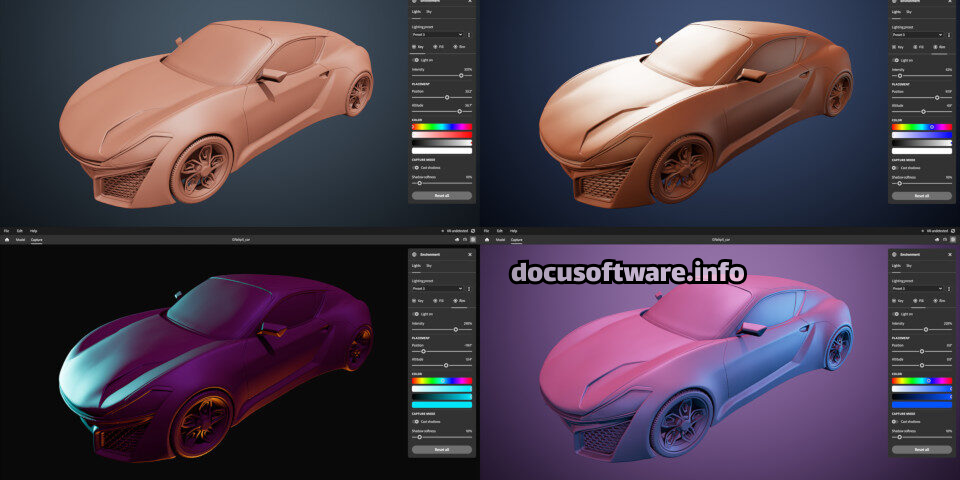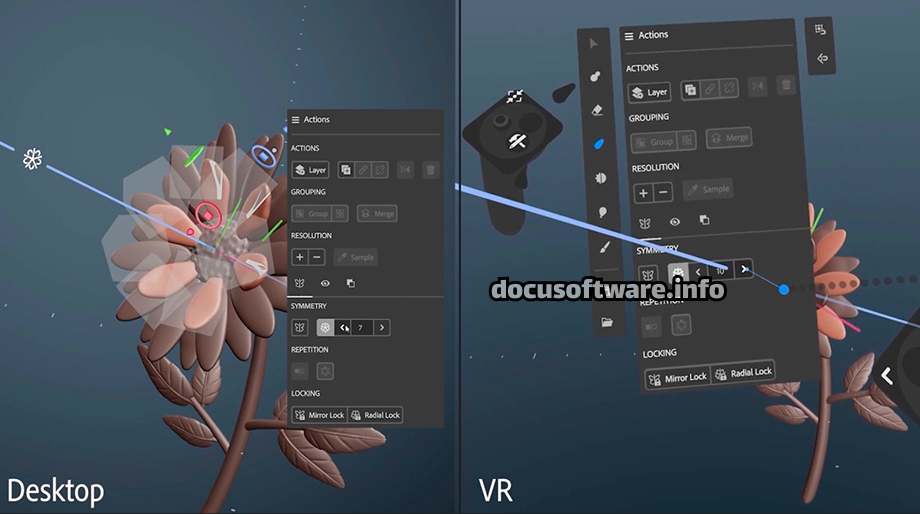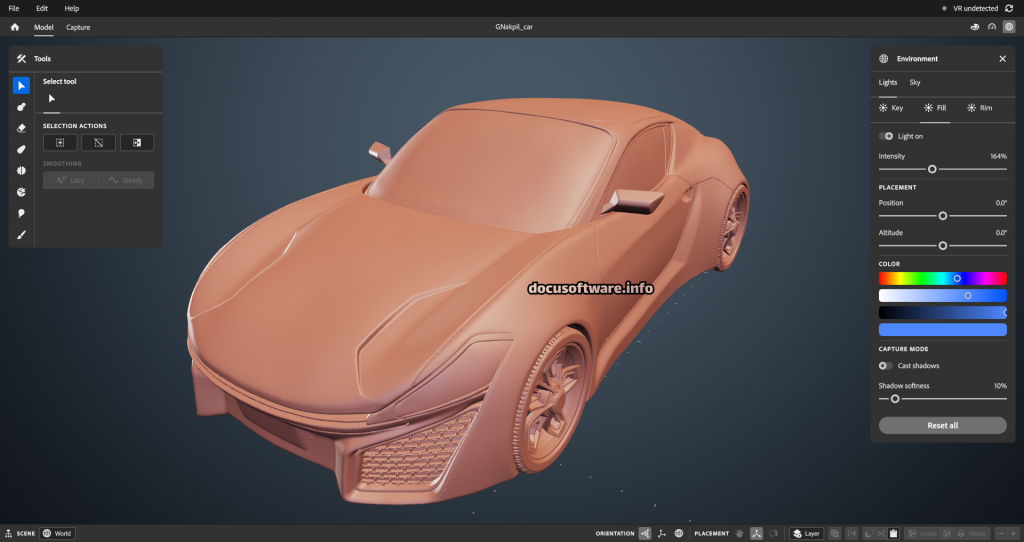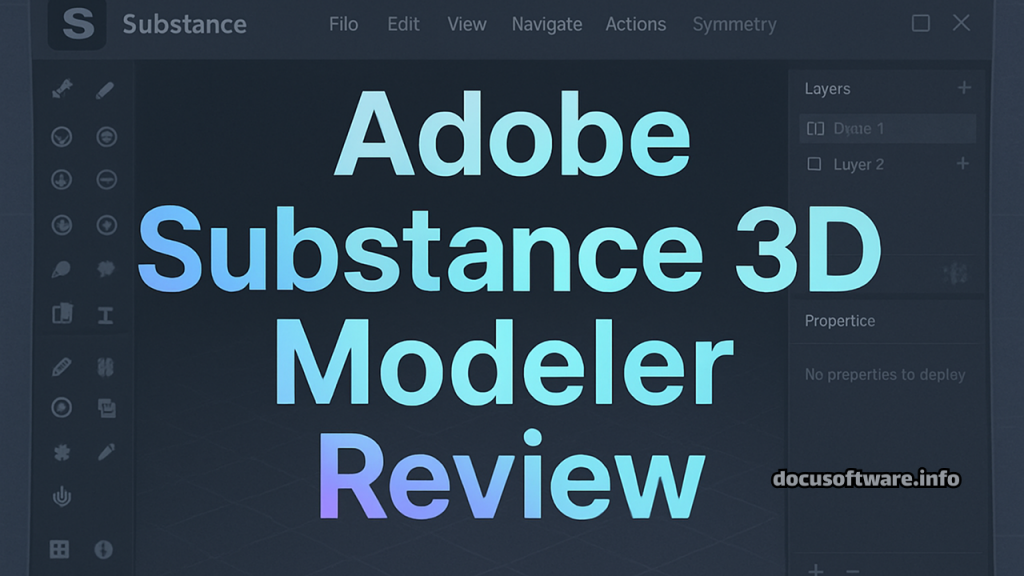Executive Summary
Adobe Substance 3D Modeler represents a paradigm shift in digital sculpting and 3D modeling, seamlessly bridging virtual reality immersion with desktop precision. This comprehensive review examines how this innovative software leverages Signed Distance Field (SDF) technology to eliminate traditional modeling constraints while delivering an intuitive, artist-friendly experience that transforms creative workflows across industries.
What is Adobe Substance 3D Modeler?
Adobe Substance 3D Modeler is a revolutionary multisurface 3D sculpting application that combines virtual reality capabilities with traditional desktop modeling. Unlike conventional polygon-based modeling software, Substance 3D Modeler utilizes advanced SDF engine technology, allowing artists to sculpt organically without concerns about topology, polygon count, or subdivision levels.
The software’s unique approach treats 3D forms as virtual clay, enabling natural, gesture-based creation that mirrors real-world sculpting techniques while maintaining the precision required for professional production pipelines.

Core Features and Technical Capabilities
Signed Distance Field (SDF) Engine
The heart of Substance 3D Modeler lies in its sophisticated SDF-based architecture. This technology represents 3D space mathematically rather than through traditional polygonal meshes, offering several revolutionary advantages:
- Unlimited resolution sculpting without performance degradation
- Non-destructive Boolean operations with real-time preview
- Automatic UV mapping and retopology during export
- Seamless level-of-detail management for any output requirement
Dual-Mode Workflow Integration
Substance 3D Modeler’s flexibility shines through its dual-mode operation system:
Virtual Reality Mode:
- Compatible with Meta Quest 2, Quest Pro, Valve Index, and Pico headsets
- Natural hand gestures for intuitive sculpting
- Immersive 360-degree workspace navigation
- Physical movement through scenes for optimal perspective
Desktop Mode:
- Full mouse and keyboard support
- Precision controls for technical modeling
- Wacom tablet integration with multitouch capabilities
- Experimental “Headless VR” combining controller precision with desktop viewing
Advanced Primitives System
The Primitives workflow, released in version 1.15, makes it possible to assemble complex hard-surface models by performing Boolean operations on 3D primitives. This system includes:
- Six specialized Combine modes: Inset, Extrude, Groove, Tongue, Repel, and Avoid
- Parametric shape manipulation for precise technical modeling
- Non-destructive workflow maintaining edit history
- Smooth or chamfered edge blending options
Professional Export Pipeline
The software delivers production-ready assets through sophisticated export capabilities:
- Multiple format support including OBJ, FBX, USD, STL, IGES, JT, and STEP
- Intelligent mesh decimation with customizable polygon density
- Automatic UV unwrapping and layout optimization
- Choice between triangulated or quad-only topology
- Direct integration with Substance 3D Painter for texturing workflows
Performance and System Requirements
Hardware Specifications
Minimum Requirements:
- Windows 10 or later (Windows-only application)
- GPU: NVIDIA GTX 1060 or AMD RX580 (4GB VRAM)
- 16GB RAM recommended
- OpenXR runtime support for VR functionality
VR Headset Compatibility:
- Meta Quest 2 and Quest Pro (via Link Cable or Air Link)
- Valve Index
- Meta Rift series
- Pico headsets with OpenXR support
Performance Optimization
Adobe says GPU memory usage can be reduced “up to 50%” for heavy scenes, demonstrating significant performance improvements in recent updates. The SDF engine maintains consistent frame rates regardless of scene complexity, crucial for extended VR sculpting sessions.

Pricing Structure and Licensing Options
Subscription Plans (As of March 2025)
Substance Collection Individual pricing will increase from $49.99 to $59.99 per month and from $549.88 to $599.88 for annual pre-paid plans:
Individual Plans:
- Monthly subscription: $59.99/month
- Annual prepaid: $599.88/year
- Includes full Substance 3D Collection access
Teams Plans:
- Monthly subscription: $119.99/month
- Annual prepaid: $1,439.88/year
- Enhanced collaboration features
Perpetual License Alternative
Perpetual licences are available via Steam, and cost $149.99, including one year of free updates. This option provides cost-effective access for individual artists preferring ownership over subscription models.
Workflow Integration and Ecosystem
Substance 3D Suite Integration
Substance 3D Modeler seamlessly integrates within Adobe’s comprehensive 3D ecosystem:
- Direct export to Substance 3D Painter for advanced texturing
- Compatibility with Substance 3D Designer for material creation
- Integration with Substance 3D Stager for scene composition
- Access to Substance 3D Assets library with 20,000+ professional materials
Third-Party Pipeline Compatibility
The software supports industry-standard workflows through:
- Universal file format support for major 3D applications
- Game engine integration (Unreal Engine, Unity)
- CAD software compatibility via STEP and IGES formats
- 3D printing optimization through STL export
Latest Updates and Innovation
Version 1.17 Enhancements
Recent updates demonstrate Adobe’s commitment to continuous improvement:
- Shape Detection Algorithm: Intelligent edge preservation during resolution increases
- Enhanced VR Controls: Improved brush responsiveness and navigation precision
- Reference Image System: Import and display concept art directly in VR workspace
- AI-Powered Search: Experimental shape-matching for asset library navigation
Future Development Trajectory
Adobe’s roadmap indicates focus on:
- Expanded AI integration for intelligent modeling assistance
- Enhanced collaborative features for remote teams
- Improved desktop-VR workflow transitions
- Extended platform compatibility considerations
Competitive Analysis
Versus Traditional Sculpting Software
Advantages over ZBrush:
- No polygon limit constraints
- Intuitive VR interface option
- Automatic retopology on export
- Cleaner Boolean operations
Advantages over Blender Sculpting:
- Superior VR implementation
- SDF-based non-destructive workflow
- Integrated Substance ecosystem
- Professional support infrastructure
Versus VR-Only Solutions
Compared to Oculus Medium:
- Professional export pipeline
- Desktop mode availability
- Active development and updates
- Enterprise-ready licensing
Use Case Applications
Game Development
- Rapid prototyping of game assets
- Character and creature design
- Environment prop creation
- Hard-surface weapon modeling
Film and VFX
- Concept visualization
- Digital maquette creation
- Previz asset development
- Organic creature sculpting
Product Design
- Industrial design iteration
- Rapid prototype visualization
- Ergonomic testing in VR
- Manufacturing preparation via CAD export
Educational Applications
- Intuitive introduction to 3D modeling
- Virtual classroom demonstrations
- Student portfolio development
- Cross-disciplinary creative exploration
Strengths and Limitations
Key Strengths
- Revolutionary SDF Technology: Eliminates traditional modeling constraints
- Dual-Mode Flexibility: Seamless VR and desktop transitions
- Professional Integration: Robust pipeline compatibility
- Intuitive Learning Curve: Natural sculpting metaphors
- Continuous Innovation: Regular feature updates and improvements
Current Limitations
- Windows Exclusivity: No macOS or Linux support
- VR Hardware Requirements: Requires capable GPU for optimal performance
- Learning Curve for Primitives: Advanced features require practice
- Subscription Cost: Higher pricing for full collection access
- File Size Considerations: SDF files can be large before optimization

Best Practices and Optimization Tips
VR Workspace Setup
- Maximize physical space for comfortable movement
- Configure refresh rates (90Hz+ recommended)
- Adjust controller straps for extended sessions
- Enable appropriate OpenXR runtime
Performance Optimization
- Regular scene cleanup and optimization
- Strategic use of resolution settings
- Efficient layer management
- Periodic export and reimport for complex projects
Workflow Efficiency
- Master grip-based navigation early
- Utilize reference images effectively
- Leverage primitives for hard-surface base meshes
- Combine VR roughing with desktop refinement
Community and Support Resources
Official Resources
- Comprehensive Adobe documentation
- Video tutorial library
- Community forums at community.adobe.com
- Discord server for real-time assistance
Third-Party Learning
- Professional workshops on Gnomon
- YouTube creator tutorials
- ArtStation workflow breakdowns
- Industry masterclasses and webinars
Future Outlook and Industry Impact
Adobe Substance 3D Modeler represents a fundamental shift in 3D content creation methodology. The convergence of VR immersion with desktop precision, combined with SDF technology’s elimination of technical barriers, positions this software at the forefront of next-generation creative tools.
As virtual production techniques become standard in entertainment and product design industries, tools that bridge physical and digital creation paradigms will become increasingly essential. Substance 3D Modeler’s approach anticipates this evolution, providing artists with workflows that scale from initial concept to final production asset.
Verdict: Who Should Use Substance 3D Modeler?
Ideal For:
- Concept artists seeking rapid 3D visualization
- Game developers requiring efficient asset creation
- VR enthusiasts exploring creative applications
- Studios implementing hybrid VR/desktop pipelines
- Educators teaching intuitive 3D fundamentals
Consider Alternatives If:
- macOS or Linux is your primary platform
- Budget constraints prohibit subscription costs
- Traditional polygon modeling is pipeline-critical
- VR hardware investment isn’t feasible
- Specialized CAD precision is paramount
Final Assessment
Adobe Substance 3D Modeler achieves a remarkable balance between accessibility and professional capability. Its SDF-based approach removes traditional barriers while maintaining the precision required for production work. The dual-mode operation system future-proofs creative workflows, allowing artists to leverage emerging VR technology without abandoning established desktop methodologies.
The new pricing includes unmetered access to Substance 3D Assets and reflects the continuous value delivered through regular updates and feature additions, positioning the software as a comprehensive solution rather than a standalone tool.
For creative professionals seeking to embrace the future of 3D content creation while maintaining production-ready output quality, Adobe Substance 3D Modeler represents an investment in both immediate capability and long-term creative evolution. Its unique position bridging experimental VR sculpting with professional pipeline requirements makes it an essential consideration for forward-thinking artists and studios.
The software’s continuous evolution, strong community support, and integration within Adobe’s creative ecosystem ensure its relevance in rapidly evolving creative industries. While the Windows-only limitation and subscription model may deter some users, the innovative features and workflow advantages position Substance 3D Modeler as a defining tool in the next generation of 3D content creation.
